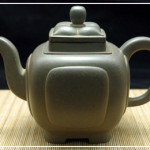Quality Basics 1: Various Plants, Various Qualities
- Leaves of Xingren Xiang Dancong, a cultivar of Fenghuang Shuixian
- Spring flush ( ie first flush ) young leaves of Wuyi Rougui. Rougui is a Wuyi native cultivar for producing the famous oolong of the same name.
- Longjing Changye, one of the major cultivars used in Longjing production, and an older one
- A local farmer showing the dark leaves of a cultivar of the Yunnan Daye sub-variety.
Tea is the dried leaves produced from the plant species Camellia sinensis. There are over a hundred different species of the genus Camellia, a lot of which are known to most gardeners as decorative plants, but only the species that we all know as the tea plant, ie Camellia sinensis, is used to make tea. There are a few varieties and hundreds of cultivars within this species. Two most known varieties are Camellia sinensis var. sinensis and Camellia sinensis var. assamica. They are used in different production locations. In some locations, a number of cultivars and varieties are employed.
Different Concepts of Tea in Different Cultures
It is commonly believed that the leaves of this plant was first used as a medicine; then as a beverage over 2 millenniums ago in China, later spreading to other East Asian countries in early centuries, and, since the Age of Discovery, to the rest of the world. It is now the most consumed beverage after water.
Tea can be a cheap card box of teabags, a pop from a vending machine, or a gift with an extreme prestige (What about € 20,000 for 100 g of Tieguanyin for your mother-in-law?). It can be a ceremonial focus in Kyoto, a lobbying tool in Beijing, a drink to degrease seductive dimsums in Hong Kong, a civilized past-time in Taipei, a labourer’s break in Mumbai, a vital family time in Casablanca, a health research focus in Paris, the Queen’s delight in Buckingham Palace, a trendy drink with tapioca in New York, and a crucial part of the daily diet for indigenous Tibetans.
To different people, tea can be used differently. It can be boiled with mint leaves and super-concentration of sugar; or blended with ginger as a folk medicine; or fluffed with yak butter and salt; or grounded to flavour an ice-cream; or sprinkled on a stir-fry with shrimps and almonds; or pickled for a salad with seafood and other vegetables. Mostly, however, it is drunk as an infusion by steeping the leaves in hot water.
Thousands of Varieties

Köhler’s drawing of the tea plant in 1897 in his collection of Köhler’s Medizinal-Pflanzen ( Köhler’s Medicinal Plants ). We have no tracing of where he got hold of this specimen to draw from. The vein counts and flower size are doubtful. Many tea cultivars can be generalised to look like this, many can be very different.
As in the making of different wines using different grapes, there are different plants of Camellia sinensis employed to make different teas. Some are very unique and regional, some are similar and used on large scale across different areas. Unlike wines, there are different methods of processing, each taking the leaves of the tea plant through a different path of biochemical changes. This results in a few categories of tea each with large varieties from producers in different regions. There are the categories of green teas, black teas, white teas, yellow teas, oolong teas, and post-fermented teas. All these different teas can be further processed for blending, scenting, or flavouring. Some others maybe compressed, crafted, powdered, mixed with other ingredients, or made into instantly dissoluble granules. They can be marketed in all sorts of names and appeals.
a confusing market
The word tea has also been used to describe other products, such as so and so herbal tea. In such cases, it is actually borrowed from the concept of tea as an infusion prepared from a plant product. Those that are not made from the leaves of Camellia sinensis are strictly speaking not tea at all. Very often, merchants are good to have labelled the product with a definitive word to contextualize the more familiar word tea, so that the consumer knows the product is made with other plants.
The situation can be a little complicated when one comes upon such products as Rose Tea (and many, many other similarly named products). It can be the flower buds of rose for infusion, or it can be a leaf tea that has been mixed with rose buds or rose petals. In some countries, product labels will help you clarify the ambiguity, in others, you really will have to get an answer from the shop.
Knowing the unique names of real teas, such as Longjing, Gyokuro, Pouchong, or a Darjeeling FTGFOP, eliminates the confusion altogether. However, since this is only the beginning of the renaissance for real tea, few people are even barely aware of such names. This is one reason we have set up this site to provide an information base for those who are interested.















